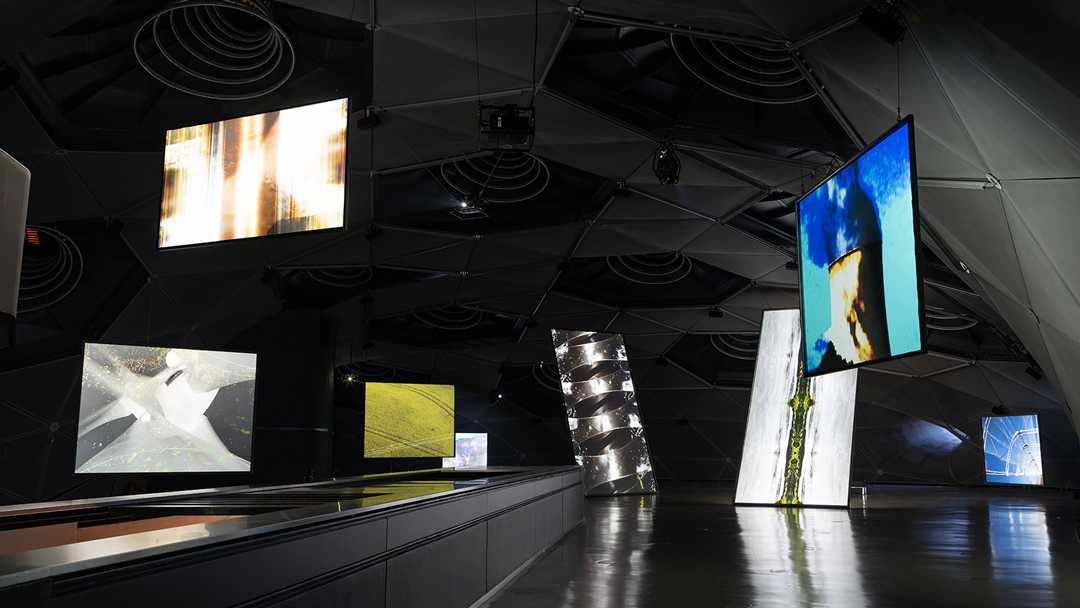Meyer Sound’s Spacemap for Primal Energies
- Details

While viewing images on the eight large screens, visitors are immersed in a blend of energy-related sounds reproduced by 64 Meyer Sound self-powered loudspeakers. The impact of the installation is further enhanced by dynamic spatial sound movements created and automated using a beta version of Meyer Sound’s soon-to-be-released Spacemap Go technology.
Sounds and images for the work were recorded on location by Fontana with assistance from Scott George of London-based Autograph Sound. During this preparatory period, Fontana and George - both of whom have long association with Meyer Sound - were recruited to serve as beta testers of Spacemap Go.
A spatial sound design and mixing tool that leverages the processing power of the Galileo Galaxy Network Platform, Spacemap Go provides ‘an easy-to-use interface for multi-channel panning using one or more iPads connected to systems comprising multiple Galaxy processors’.
“We used Spacemap Go extensively on Primal Energies,” says Fontana. “It’s the ‘digital brain’ behind all that is happening with dynamic spatialisation of sound. In that realm, it lets me do everything I did before using the D-Mitri system, but working directly with Galaxy makes it far more cost effective, particularly if you are planning something as a permanent installation in a museum or architectural setting.”
Fontana also was impressed by the creative freedom afforded by Spacemap Go’s intuitive iPad app. “We used the iPad to set up everything on site. We wanted to create a kind of sonic choreography through the space, and the flexibility of Spacemap Go made it the ideal tool for making that happen.”
Scott George has collaborated with Fontana on more than a dozen projects over the years, and with Primal Energies he was again charged with overall AV system design, as well as design specifics for the audio system within the 900 m2 space.
Fontana’s ‘sonic canvas’ was a matrixed grid of 56 Meyer Sound UPM-1P full-range loudspeakers augmented by eight 900-LFC low-frequency control elements. For the front end of the audio system, George specified a Mac Mini computer loaded with QLab software for the 24 channel playback and central show control, connecting to the four distributed Galaxy processors over an AVB network. All the spatial trajectories were created on site with Spacemap Go then saved as a file for automated panning in synchronization with the playback programme.
“The iPad interface for Spacemap Go makes it much simpler and more intuitive for the sound artist to grab a sound and move it around wherever desired, rather than using a mouse or a keyboard,” observes George. “This also allows Bill to bring in multiple cues at the same time, so he can try out various trajectories before we save them. And the fact that you can use multiple iPads simultaneously allows sound artists to work collaboratively in the same space.”
Another key member of the Primal Energies project team was Martin Beck of the Austrian firm Technik für Kunst and Kuturprojekte. Beck supervised the on-site installation and his company also provided all AV equipment, except for the Meyer Sound loudspeakers which were provided by PRG Hamburg.
Primal Energies was curated by Katrin Bucher Trantow and is presented in cooperation with the University of Art Graz, Ö1 Kunstradio (ORF), Radio Helsinki, mur.at, FunkFeuer Graz and the Kultur inklusiv Project, with further support from the AVL Cultural Foundation.
















